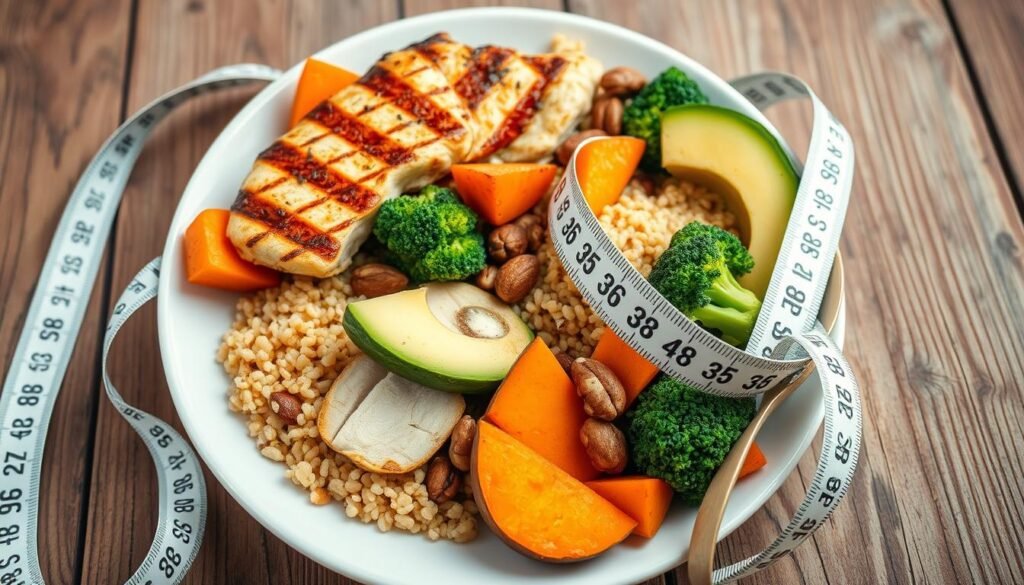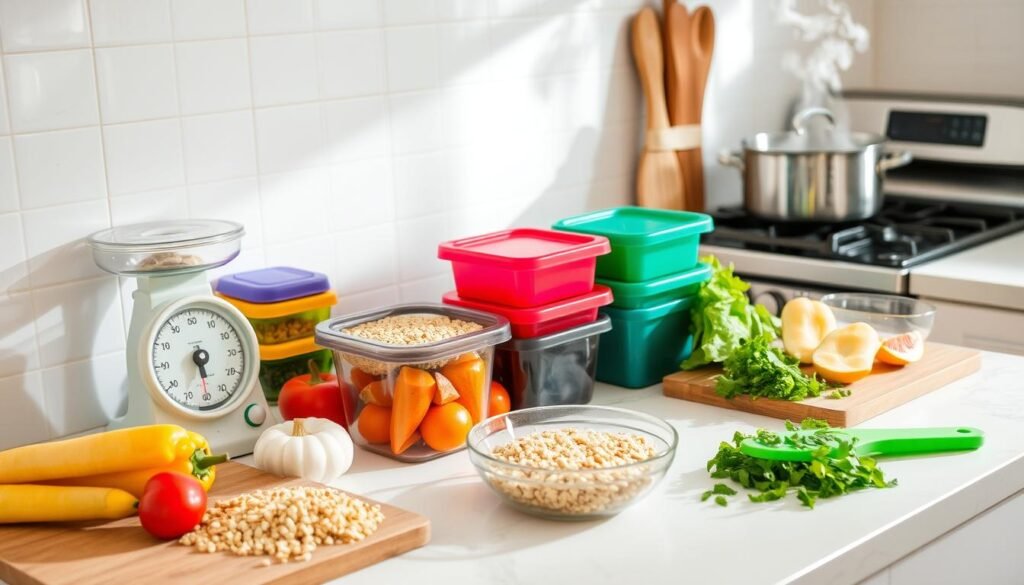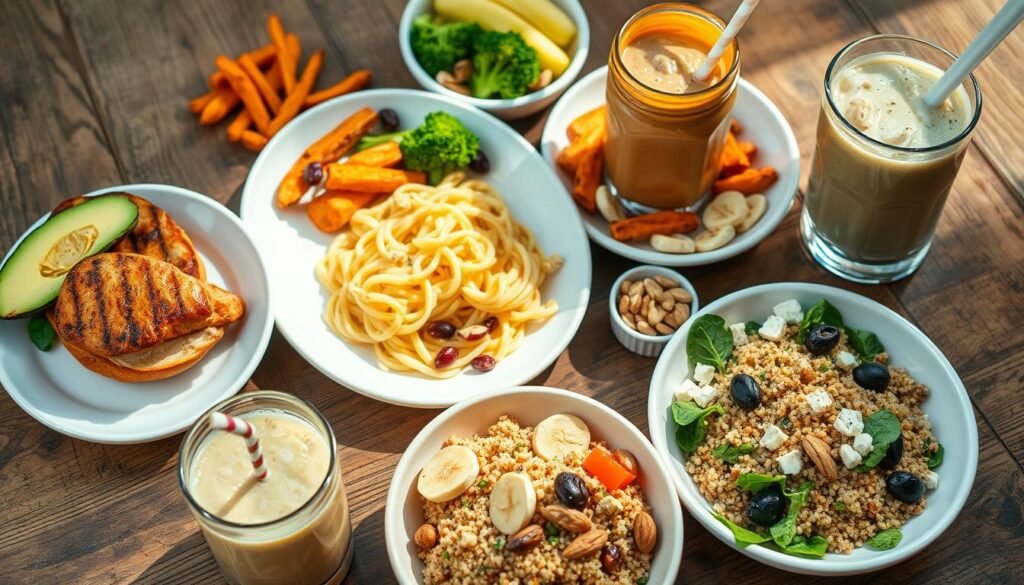Did you know that if you’re bulking, you need 1.2 to 2.0 grams of protein per kilogram of your weight every day? Choosing the right meals is key for those focused on muscle growth and fitness. Good bulking lunch ideas can provide the essential nutrients needed. They are rich in protein and have lots of calories.
Eating nutritious lunches not only helps with getting enough calories. It also aids in recovery and performance during workouts. Whether you’re making a quick meal or planning for the week, knowing how to prepare meals is beneficial. It boosts your journey and keeps you full of energy. We will look at how tasty bulking lunch ideas can help you reach your fitness goals more easily.
Key Takeaways
- Protein levels in bulking meals range from 18g to 40g per serving.
- For best growth, lunch should have 400 to 550 calories.
- Meal prep includes options for different diets, like vegetarian.
- Healthy fats from avocados and nuts are important for a balanced diet.
- Most bulking lunches can be made in less than 60 minutes.
- Knowing how to store and reheat meals is key for meal prep success.
Understanding the Importance of Bulking Lunches
Bulking lunches are key for boosting energy and muscle growth. They provide vital nutrients we need to perform our best. When eaten at the right time, they help fight off tiredness after working out and speed up recovery. A good lunch keeps your energy up all day. It helps you watch your calories and meet your workout goals.
Having healthy lunch choices makes it easier to avoid bad food at noon. Good meal planning helps you eat more calories than you burn to gain weight. For a clean bulk, aim to eat 10–20% more calories. This way, you gain weight steadily and healthily.
For a man weighing 175 pounds, an extra 250–500 calories are needed for bulking. A woman at 135 pounds should add 200–400 calories for the same effect. Eating mostly whole, unprocessed foods is best for a clean bulk, making up about 90% of your diet.
Finding good meal ideas for gaining weight helps keep your diet balanced. Meal prep is a great way to control what you eat. It’s recommended for anyone serious about bulking. Planning meals ensures you get enough protein, aiming for 0.7–1 gram per pound of your weight.
Adding these nutritious lunches can really help you stay on track with your bulking goals. It allows you to enjoy the perks of eating right and timing your meals well.
What is Bulking and Why is it Important?
Bulking is crucial for anyone wanting a more muscular body. It means eating more calories than you burn. This leads to muscle mass and strength gains. By doing this, your gym efforts pay off more visibly over time.
Men and women typically need different calories during bulking. Men might consume about 3,800 calories a day, while women might need 3,200. This helps gain about 0.25 to 0.5 percent of body weight each week. For a 150-pound person, that’s between 0.4 and 0.8 pounds weekly.
To grow muscles well, eating the right mix of foods is key. Ideally, 45 to 60 percent of your calories should be carbs. Protein should make up 30 to 35 percent, and fat 15 to 30 percent. This mix fuels tough workouts and helps fix and build muscles afterwards.
Eating healthy during bulking is a must to stay well. Avoiding junk food keeps you from health problems like high inflammation and insulin issues. Eating whole, nutritious foods helps gain muscle, not fat.
Adding supplements like whey and casein protein helps too. They support muscle growth and recovery. Understanding and following bulking best practices is the path to reaching fitness goals.
Caloric Needs During a Bulking Phase
Finding out how many calories you need for bulking is key to gaining muscle well. When bulking, people need more calories than usual to grow muscle. This means eating 500 to 1000 calories more than your Basal Metabolic Rate (BMR) daily. You can use online tools to figure out these numbers, making it easier to reach your fitness goals.
Knowing how much energy you need helps you make a good bulking plan. For muscle building, men should start with at least 3000 calories a day. Women usually need about 2500 calories. This is the start of making meal plans that help muscle growth but keep fat gain low.
You don’t have to count every single calorie. Watching your general calorie trends is more helpful. You should eat 40-60% of your calories from carbs, 25-35% from protein, and 15-25% from fat. This mix makes meals satisfying and nutritionally balanced.
When planning meals, choose foods that are high in calories. Adding bulking meals, like high-protein snacks and foods rich in nutrients, helps you meet your daily calorie needs. Protein is very important, especially after exercising. Aim for 0.14 to 0.23 grams of protein per pound of your weight to aid muscle recovery and growth.
| Caloric Breakdown | Percentage |
|---|---|
| Carbohydrates | 40-60% |
| Protein | 25-35% |
| Fat | 15-25% |
| Recommended Surplus | 500-1000 calories |
| Daily Intake Example (Men) | 3000+ calories |
| Daily Intake Example (Women) | 2500+ calories |
A smart plan for calorie and macronutrient intake is key to effective bulking. Begin with a caloric surplus and adjust as you see changes. This approach will help you achieve the body you want, without gaining unwanted fat.
Essential Macros for Muscle Building
Getting the right balance of macros is key for those wanting to build muscle. You should aim for 40% protein, 35% carbs, and 25% fats. This combo helps grow muscles and supports recovery after you work out.
Protein is super important for muscle growth. You need 1.4 to 2 grams of it per kilogram of your weight every day. Eating meals like barbecue chicken with rice, which has 41 grams of protein, shows it’s easy to get enough.
Carbs are also crucial. They fuel your workouts and refill your energy stores. For example, a cup of cooked quinoa has about 40 grams of carbs. It’s great for keeping your energy up when you exercise hard.
Don’t forget about healthy fats. Foods like olive oil, avocados, and nuts add necessary calories for bulking up. They help with hormone production and give you energy, too.
- Focus on whole, nutrient-dense foods to meet macronutrient targets.
- Track and adjust ratios based on individual progress and adjustments.
- Experiment with various meal combinations to find what works best.
Meal prep makes it easier to keep track of these macros. It lets you manage what you eat better. Paying attention to these nutrients is crucial for reaching your muscle-building goals.

Meal Prep: A Key Factor in Bulking Success
Meal prep is key for reaching fitness goals while bulking. It makes sure you always have healthy meals ready. This helps save time and keeps you on track with your diet, important for building muscle. Easy meal prep is vital for consistent nutrition and avoiding junk food.
Meal planning greatly increases your chances of hitting dietary targets. People who prepare their meals tend to stick to their nutrition goals better. They eat the right amounts of proteins, carbs, and fats. In fact, meal prepping could make you 30% more likely to follow your diet. Specially, getting enough protein, about 1.6 to 2.2 grams per kilogram of body weight, is easier.
To make meal prep easier, try cooking in batches. This method can cut cooking time by up to 60%. By doing this, you can enjoy a variety of meals without extra work. Use foods full of nutrients like chicken breast, quinoa, and sweet potatoes. They help keep your protein, carbs, and fats in the right balance.
Effective meal prep is great for bulking. It boosts your health and helps you recover faster. It means you can spend more time focusing on workouts and less on what to eat. To learn more about meal prep for gaining weight, see this detailed guide.
Simple Steps to Start Your Meal Prep
Starting your meal prep journey is both easy and fun. By following a few meal prep steps, you can make bulking up efficient and effective. Let’s talk about some key steps you should consider:
- Create a Weekly Menu: Planning your meals ahead gives you a clear shopping list and helps you eat balanced meals that meet your bulking goals.
- Sourcing Ingredients: Choose high-quality, in-season ingredients to help keep nutrients in your food and cut down on grocery bills.
- Batch Cooking: Cook your meals in big batches. It saves time and ensures you always have meals ready. Using every ingredient in more than one meal boosts your efficiency.
- Proper Storage: Get airtight, stackable containers to keep your meals fresh. This can make your food stay tasty up to 50% longer.
- Portion Control: Measure your food with a scale for precise macros. This is crucial for following your bulking meal plan closely.
- Meal Tracking: Use apps to keep an eye on your macros and calories. This helps you stick to your diet goals more easily.
By following these bulking meal prep tips, you can enjoy meal prep and stick with it. Efficient meal prep saves time, reduces food waste, and cuts down on costs. And most importantly, as you dive into meal prepping, you’ll likely feel more satisfied with your diet. This satisfaction is key for hitting your fitness targets.

| Action | Description | Benefits |
|---|---|---|
| Create a Weekly Menu | Plan all meals in advance. This makes shopping simpler. | Leads to balanced eating and less spontaneous, unhealthy choices. |
| Sourcing Ingredients | Pick high-quality, seasonal goods for more nutrients. | Helps save money and ups meal quality. |
| Batch Cooking | Cook big portions to always have meals ready. | Saves time and lets you have a variety of dishes. |
| Proper Storage | Store meals in airtight containers for freshness. | Keeps food from spoiling and tastes better longer. |
| Portion Control | Use a scale for exact ingredient measures. | Better macro tracking and meeting dietary targets. |
| Meal Tracking | Use apps for precise food logging. | Makes sticking to nutrition plans easier and more accurate. |
Bulking Lunch Ideas: Nutrient-Dense Recipes
When you are building muscle and gaining weight, it’s key to eat nutrient-dense lunches. These meals have to be rich in calories but also balanced. They should offer plenty of protein, healthy fats, and carbs. Let’s look at three awesome bulking lunch ideas.
Grilled Chicken Salad with Quinoa
This lunch features lean grilled chicken and quinoa, a great combo for protein and fiber. Quinoa is super for bulking up, as it has about 8 grams of protein per cup. Combine it with various greens and your choice of dressing for a tasty nutrient-packed meal.
Beef and Brown Rice Stir-Fry
Our next recipe is a beef and brown rice stir-fry that’s quick and full of protein. It delivers around 30-35 grams of protein per portion to help muscle recovery. The addition of colorful veggies adds vital nutrients and flavors, perfect for busy schedules.
Stuffed Peppers with Ground Turkey
Stuffed peppers offer a flexible meal prep option. They’re filled with ground turkey for a good protein boost, usually more than 30 grams per serving. Spices can make the dish even tastier. It’s a recipe that supports a balanced diet and the calories you need for bulking.
These bulking lunch recipes aren’t just high in protein. They also fit well into a thoughtfully planned diet. According to this guide on high-calorie foods for bulking, focusing on meal prep and nutrient-dense food makes bulking up more effective.
High Calorie Meals to Boost Your Training
For those into strength training and muscle growth, high calorie meals are a must. These meals can make your workouts better and help you recover faster. Here are three tasty and healthy recipes that will up your calorie intake and delight your taste buds.
Chicken and Sweet Potato Power Bowl
This bowl has grilled chicken, roasted sweet potatoes, and greens. It’s packed with protein and complex carbs. The chicken helps fix muscles, and sweet potatoes bring fiber and vitamins.
Vegetarian Chili with Kidney Beans
Our hearty chili boasts kidney beans, tomatoes, and spices. It’s a great vegetarian pick. It’s full of protein and fiber, keeping you full longer. Plus, it’s simple to make, perfect for a busy week.
Salmon with Roasted Vegetables
Salmon is great for muscle recovery thanks to its healthy fats. When you add roasted veggies, you get a nutrient-rich meal. This dish is delicious, proving high-calorie foods can be part of building muscle.
| Recipe | Protein (g) | Calories | Preparation Time |
|---|---|---|---|
| Chicken and Sweet Potato Power Bowl | 30 | 600 | 30 mins |
| Vegetarian Chili with Kidney Beans | 15 | 400 | 40 mins |
| Salmon with Roasted Vegetables | 25 | 550 | 25 mins |

Protein-Rich Lunches for Optimal Recovery
Protein-rich lunches are key for healing after workouts. They help fix muscles, boost recovery, and cut down on cravings. Here are some tasty meals that pack the right nutrients.
Turkey Meatballs with Whole Wheat Pasta
Lean turkey meatballs and whole wheat pasta make an awesome recovery meal. The turkey brings a lot of protein. Whole grains give long-lasting energy. This combo is great for fixing muscles.
Tuna Salad Wraps with Greek Yogurt
For a quick, yummy lunch, try tuna salad wraps. They mix high-protein tuna with creamy Greek yogurt. This meal is perfect for staying full. It helps you recover after exercising.
Cottage Cheese and Pineapple Combo
This combo is light but refreshing for refueling. Cottage cheese and pineapple mix well. You get protein and natural sugars. It’s great for healing without too many calories.
Nutritious Lunch Options for Weight Gain
Eating the right lunch is key for gaining weight. Meals full of protein help build muscle. Here are some tasty and nutritious lunch ideas.
Egg Salad BLT on Ezekiel Bread
This sandwich mixes eggs, lettuce, and tomatoes on Ezekiel bread. With over 15 grams of protein, it’s great for adding calories. Eating whole grains brings more nutrients, making it a good lunch for weight gain.
Roasted Veggie Quinoa Salad
This salad has roasted veggies and quinoa, a protein powerhouse. It’s full of fiber for good digestion. Making it ahead of time lets the flavors blend, supporting your weight gain goals.
Turkey Club Sandwich with Hummus
Using hummus instead of mayo adds taste without extra calories. This sandwich is packed with protein and veggies. Whole-grain bread increases fiber, making it a top choice for a healthy lunch.
Add these meals to your daily plan for energy and muscle growth. For more ideas on high-calorie meals, visit this resource.
| Lunch Option | Protein (grams) | Preparation Time (minutes) | Rating (out of 5) |
|---|---|---|---|
| Egg Salad BLT on Ezekiel Bread | 15 | 10 | 4.7 |
| Roasted Veggie Quinoa Salad | 18 | 10 | 4.6 |
| Turkey Club Sandwich with Hummus | 20 | 10 | 4.8 |
Conclusion
In summary, exploring bulking lunch ideas shows their importance in reaching fitness goals. This article gave readers a variety of nutritious recipes. It proved that meal prep for bodybuilders can be simple and affordable.
By knowing how much to eat and understanding nutrients, anyone can match their diet to their bulking goals. Good meal planning helps athletes stay on track with their objectives. It also helps achieve better muscle growth and health.
Learning about bulking lunch ideas is key for setting up good eating habits. Taking steps towards a good meal plan keeps energy up and progress in check. By using these tips, anyone can improve their fitness journey and reach their full potential.